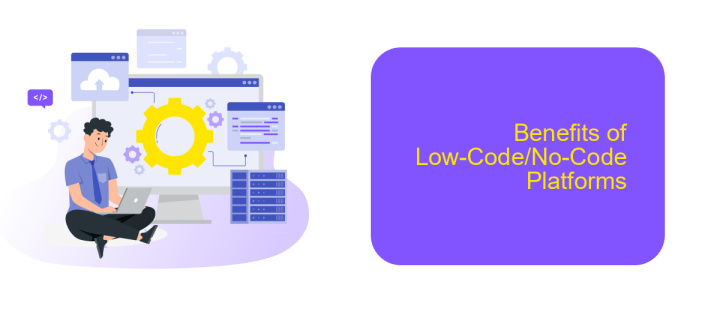Low-Code/No-Code Platforms
Low-code and no-code platforms are revolutionizing the way businesses develop software by enabling users with little to no programming experience to create applications. These platforms use visual interfaces and drag-and-drop features, significantly reducing development time and costs. As a result, they empower organizations to innovate faster and adapt more quickly to changing market demands.
Introduction
In the rapidly evolving digital landscape, Low-Code/No-Code platforms are revolutionizing the way businesses approach software development. These platforms enable users with minimal or no coding skills to create applications, automate workflows, and integrate various services seamlessly. By democratizing the development process, they empower organizations to innovate faster and reduce dependency on traditional IT resources.
- Accelerated development timelines
- Reduced costs and resource allocation
- Enhanced flexibility and adaptability
- Empowerment of non-technical users
One of the key advantages of Low-Code/No-Code platforms is their ability to simplify integrations with other services. Tools like ApiX-Drive facilitate this process by offering a user-friendly interface for connecting various applications and automating data flows. This not only boosts productivity but also ensures that businesses can quickly adapt to changing market demands. As a result, Low-Code/No-Code platforms are becoming indispensable assets for modern enterprises.
Low-Code Development

Low-code development is a streamlined approach to software creation that minimizes the need for extensive hand-coding. By using visual interfaces and pre-built components, developers can quickly assemble applications, significantly reducing development time and cost. This method is ideal for businesses looking to accelerate their digital transformation without the need for extensive coding knowledge. It empowers both professional developers and non-developers to collaborate and innovate, making technology more accessible across the organization.
One of the key advantages of low-code platforms is their ability to integrate with various third-party services seamlessly. For instance, ApiX-Drive is a powerful tool that facilitates the integration of different applications without the need for complex coding. By leveraging such services, businesses can automate workflows, synchronize data, and enhance operational efficiency. This not only simplifies the development process but also ensures that applications can easily adapt to evolving business needs.
No-Code Development

No-code development empowers individuals to create software applications without writing any code. This approach leverages visual interfaces and drag-and-drop tools, making it accessible to non-technical users. By simplifying the development process, no-code platforms enable faster prototyping and deployment, reducing the time to market for new applications.
- Visual Interface: Users can design application workflows and user interfaces using simple drag-and-drop editors.
- Pre-built Templates: Many no-code platforms offer a variety of templates to kickstart the development process.
- Integration Capabilities: Tools like ApiX-Drive facilitate seamless integration with various third-party services and APIs.
- Scalability: No-code solutions often include features to scale applications as user needs grow.
With the rise of no-code platforms, businesses can now empower their teams to innovate without relying heavily on IT departments. This democratization of software development fosters creativity and allows for rapid iteration. By utilizing tools like ApiX-Drive, users can easily integrate their applications with other services, enhancing functionality and streamlining workflows.
Benefits of Low-Code/No-Code Platforms

Low-Code/No-Code platforms offer numerous benefits, making them increasingly popular in the software development landscape. These platforms empower non-technical users to create applications without extensive coding knowledge, thus democratizing the development process.
One of the primary advantages is the significant reduction in development time. By utilizing visual interfaces and pre-built components, users can rapidly prototype and deploy applications. This accelerates the time-to-market, allowing businesses to respond swiftly to changing market demands.
- Cost Efficiency: Reduces the need for extensive coding and specialized developers.
- Flexibility: Easily adaptable to changing requirements and business needs.
- Enhanced Collaboration: Facilitates better communication between technical and non-technical teams.
- Integration Capabilities: Platforms like ApiX-Drive simplify the process of connecting various applications and services.
Moreover, these platforms foster innovation by enabling users to experiment with new ideas without the constraints of traditional development cycles. As a result, businesses can continuously improve their operations and customer experiences, staying competitive in a fast-paced digital environment.
- Automate the work of an online store or landing
- Empower through integration
- Don't spend money on programmers and integrators
- Save time by automating routine tasks
Conclusion
Low-Code/No-Code platforms have revolutionized the way businesses approach software development, making it accessible to a broader range of users. By lowering the technical barriers, these platforms empower non-developers to create and deploy applications quickly and efficiently. This democratization of technology not only accelerates innovation but also reduces costs and dependence on specialized IT resources, enabling organizations to respond more swiftly to market changes and customer needs.
Moreover, the integration capabilities of platforms like ApiX-Drive further enhance the utility of Low-Code/No-Code solutions. ApiX-Drive allows seamless connectivity between various applications and services, simplifying data synchronization and process automation. This integration flexibility ensures that businesses can maintain a cohesive and efficient digital ecosystem, maximizing the value derived from their Low-Code/No-Code investments. As these platforms continue to evolve, they are poised to play an increasingly pivotal role in the digital transformation journeys of organizations worldwide.
FAQ
What are Low-Code/No-Code platforms?
Who can benefit from using Low-Code/No-Code platforms?
Can Low-Code/No-Code platforms handle complex applications?
How do Low-Code/No-Code platforms integrate with other systems?
Are Low-Code/No-Code platforms secure?
Time is the most valuable resource in today's business realities. By eliminating the routine from work processes, you will get more opportunities to implement the most daring plans and ideas. Choose – you can continue to waste time, money and nerves on inefficient solutions, or you can use ApiX-Drive, automating work processes and achieving results with minimal investment of money, effort and human resources.


